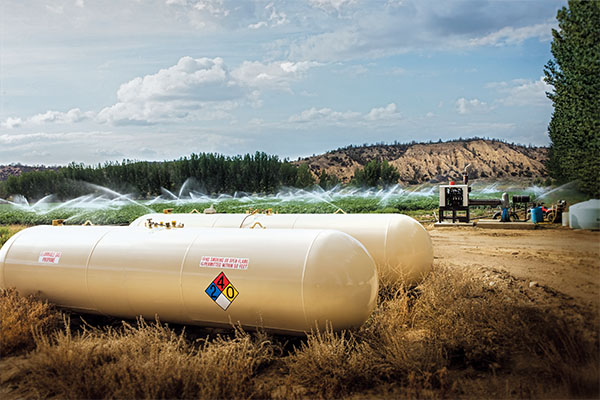Propane proves reliable on the farm amid unpredictable weather
Propane marketers – and the farmers they serve – must be prepared for virtually any weather condition, from lower-than-normal temperatures that necessitate heating for livestock, to rain events that delay crop planting, to dry spells that lead to upturns in irrigation gallons.
In recent years, the pressures have grown. The U.S. experienced 20 separate billion-dollar weather and climate disasters in 2021, according to the National Oceanic and Atmospheric Administration’s National Centers for Environmental Information. The 1980-2021 annual average is 7.4 events, while the average for the most recent five years is 17.2 events.
Frequently, prolonged power outages occurred during or immediately following those severe weather events. Severe weather-related problems have driven much of the increase in prolonged outages, according to the U.S. Department of Energy.
Propane marketers across the country have stepped up efforts to communicate with ag customers and provide the energy necessary to keep farms operational amid unpredictable weather conditions. As the need for clean, reliable energy on the farm increases alongside severe weather events, propane-powered equipment can offer customers immediate solutions that meet operational and environmental goals.
Iowa: Drought and derechos
The country’s predominant producer of corn, Iowa experienced a very wet fall in 2019, leading to a significant crop drying year for propane marketers, says Deb Grooms, CEO of the Iowa Propane Gas Association (IPGA).
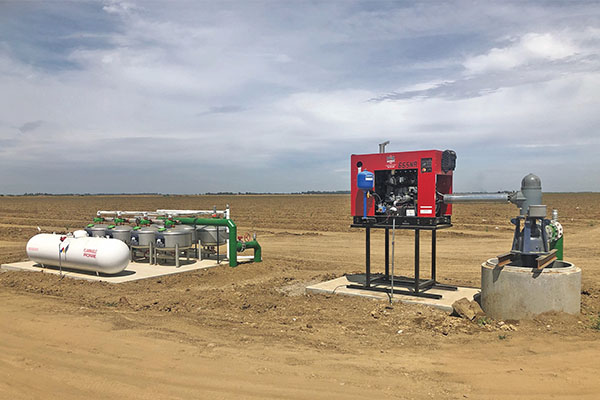
N&S Tractor in California has seen lower demand for propane-powered irrigation engines this year due to supply chain issues and exceptional drought conditions that have limited planting. (Photo courtesy of N&S Tractor)
The following year, a derecho devastated Iowa’s cropland with hurricane-force winds and torrential downpours.
About 12 million acres of cropland were affected by the August 2020 derecho – 50 percent of all acres planted in Iowa in 2020, according to consulting firm McKinsey & Co. Up to 3.8 million acres sustained physical crop damage, and 90 percent of the damage affected corn. McKinsey & Co. estimates that crop production was partially lost in 85 percent to 90 percent of the damaged acres and completely lost in 10 percent to 15 percent.
In 2021, Iowa’s agriculture industry encountered yet another severe weather event: a drought. The drought led to limited corn drying, a negative consequence for the propane market. By November 2021, 43 percent of Iowa’s corn acres were experiencing a moderate to severe drought, while 28 percent of the state’s soybean acres were experiencing a moderate drought, according to the U.S. Department of Agriculture’s (USDA) Office of the Chief Economist and World Agricultural Outlook Board.
The drought has since retreated, though, as Iowa experienced a relatively wet spring this year.
“Since we had a wet spring, planting was late,” says Grooms. “At this time, we could have a late harvest and may have to dry a lot of corn, but that all depends on the summer heat and fall rains. It’s all up to Mother Nature.”
So far this year, Mother Nature has proven volatile. On May 12, for instance, yet another derecho occurred in the state, although much milder than the one that occurred in August 2020, according to the Iowa Department of Agriculture and Land Stewardship. Impacts of the storm were reported as more severe in neighboring states South Dakota and Minnesota.
To help propane marketers and their ag customers prepare for irregular or severe weather conditions, IPGA hosts a Propane Stakeholders Group that conducts conference calls throughout the summer and fall to discuss crops and propane supplies.
“The IPGA encourages our propane marketing members to meet with their customers, wholesale suppliers and transporters, and make plans ahead of the harvest and heating season,” Grooms says.
Crop conditions in Iowa still signal a potentially strong season ahead. By June 19, corn, soybean, oat and hay conditions were 83, 80, 82 and 73 percent good to excellent, respectively. According to the USDA, 93 percent of soybeans had emerged – six days behind 2021, yet three days ahead of the average.
Minnesota: Too dry, too wet
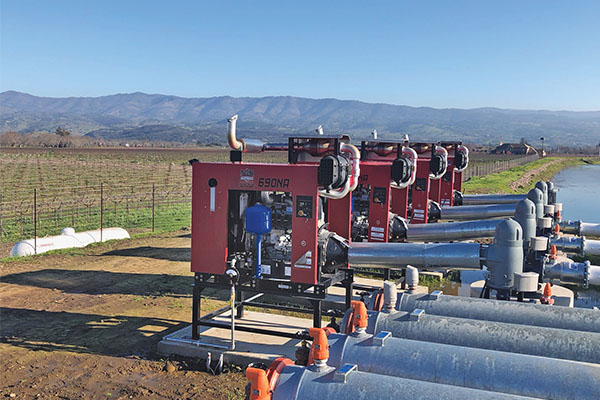
Drought conditions can limit crop yields and, thus, crop drying gallons, but can also support demand for propane-powered irrigation engines. (Photo courtesy of N&S Tractor)
Minnesota also experienced a drought last year, leading to a decline in propane usage within the agriculture industry. Prior to this drought, the state’s propane industry saw three consecutive years of above-average gallon sales due to either later planting dates or lower heating and growing degree units, says Dave Wager, executive director of the Minnesota Propane Association.
Dry conditions began in early 2020 and reached a peak during the summer of 2021, according to the Minnesota Department of Natural Resources.
Drought coverage accelerated throughout June, with areas in “moderate drought” or worse growing by more than 500 percent. By the end of July, 22 percent of the state was in an “extreme drought,” and by Aug. 10, parts of northwestern and north central Minnesota were experiencing an “exceptional drought” – the state’s highest level of drought in the 21-year history of the U.S. Drought Monitor.
The drought was the worst experienced by farmers and propane marketers in 10 to 40 years, depending on the area of the state.
Ultimately, relief came, as December 2021 was the second wettest on record on a statewide basis.
The wet weather continued into the spring and is now cause for concern as the harvest approaches, says Wager.
“When the majority of the Corn Belt in the U.S. has a wet spring, that compresses the planting dates,” he says. “This can lead to a compressed harvest season happening all at once instead of the more normal ‘south to north’ harvesting season. This puts an immense amount of pressure on all of the transportation assets and supply of propane where it is needed.”
In addition, May’s derecho was more severe in southwestern Minnesota than it was in Iowa.
The impact on grain facilities was reported as severe, and it’s unknown how many of those facilities can be repaired and operational by harvest, says Wager. However, the storm did not damage Minnesota’s crop since little to no emergence had occurred at that point in the year, he adds.
Wager is cautiously optimistic as he looks ahead to the harvest.
“This year’s spring rains’ and late planting dates’ impacts aren’t completely known at this time,” he says. “Gallon sales for the last growing season were down statewide, due to the drought – yet pockets of the state still reported good gallon sales, as a result of different growing and weather conditions.”
Wager advises farmers to implement a “layering in” approach to planning for the harvest. By adding “layers” of whatever they need at their farms – whether it’s equipment, fungicides or propane – throughout the growing season, as crop condition becomes more evident, farmers will be more prepared for unpredictable weather conditions.
“Propane marketers should encourage this approach as much as possible,” Wager stresses. “I also advise marketers to recommend increased storage to their customers, which helps bridge the high demand periods that will come suddenly with grain drying or extended dry spells. Prepare now to avoid regrets later.”
South: Hurricane Michael
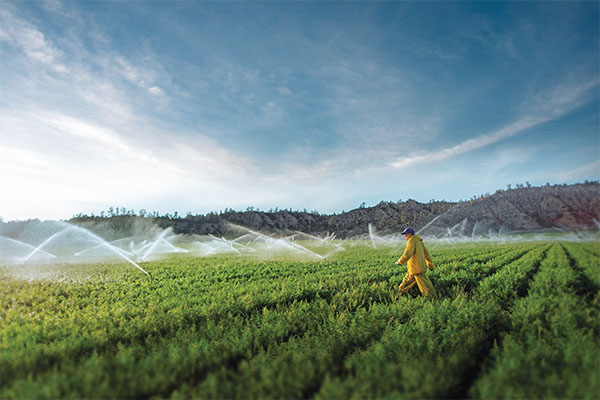
A wet spring across the Midwest this year may lead to a later harvest and crop drying season that coincides with the beginning of the propane industry’s heating season. (Photo courtesy of the Propane Education & Research Council)
From early to mid-October 2018, Hurricane Michael devastated much of the South as the first Category 5 hurricane to make landfall within the contiguous U.S. in 26 years. With winds as high as 160 mph, the storm caused more than $25 billion in reported damage.
The hurricane was especially devastating in the central Florida Panhandle. Agricultural operations – a crucial component of the local economy – were considerably damaged, particularly near the Interstate 10 corridor and into southwest Georgia. For instance, in Donalsonville, Georgia, a small town located about an hour from Tallahassee, Florida, winds as high as 115 mph toppled large trees, aged up to 150 years, onto various farm structures.
Prior to the hurricane, the harvest had shown promising signs due to a lot of rain earlier in the year. But when the storm arrived, 50 to 80 percent of a potentially record-breaking crop was suddenly lost, according to Bill Moore, alternative fuel sales manager at Tifton, Georgia-based Conger LP Gas.
“We had thousands of acres of cotton become hundreds, and that reduced the demand for propane for irrigation wells,” Moore says. “The peanut and corn crops were also impacted substantially, especially in my area, again leading to a significantly negative impact on propane demand.”
Within the Florida Panhandle, $50 million of loss and damage occurred to cotton crops, while $23 million of loss and damage impacted peanut crops, according to the University of Florida.
Southwest Georgia incurred the following agriculture sector losses: $74 million in cotton, $69 million in vegetables, $24.7 million in pecans and $1.6 million in peanuts, according to the University of Georgia.
Thus far, the South has experienced a hot, dry summer. Severe drought has been reported in North Carolina, while moderate drought conditions have been observed in Florida, Georgia and South Carolina, according to the Southeast Regional Climate Center.
As a result, farmers are running irrigation when they plant just to get seeds in the ground, leading to an increased demand for propane-powered irrigation equipment, says Moore.
“It’s impossible to know the exact number of gallon sales impacted by severe weather,” Moore says. “We do know it can have a significant impact in either direction, as the current drought has increased demand, while Hurricane Michael had a negative impact.
“Hopefully, we can overcome our supply chain issues with propane-powered equipment so that farmers can acquire what they need.”
California: A ‘perfect storm’
California is renowned for its agriculture industry, as it produces a variety of crops – almonds, corn, grapes, peaches, prunes, rice, strawberries, tomatoes and wheat, to name a few. Regardless of the crop, virtually every farmer irrigates with a well or “district water,” as various water districts allocate the water from rivers and reservoirs.
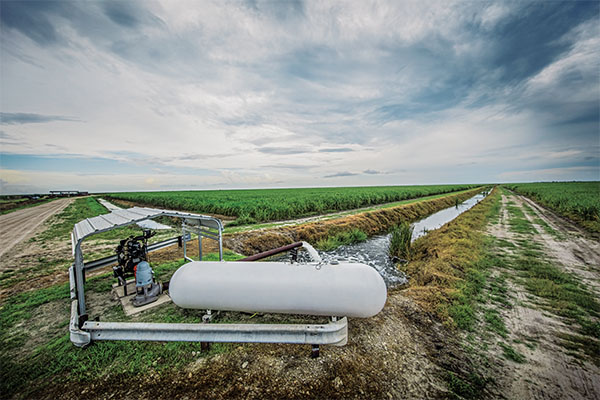
Propane-powered equipment proves more reliable than gasoline, diesel and electric counterparts during prolonged power outages. (Photo courtesy of the Propane Education & Research Council)
Severe, extreme and exceptional drought conditions are affecting the vast majority of the state, according to the National Interagency Fire Center. From January to April, statewide precipitation was only 25 percent of the average during that four-month period – California’s driest start to a year ever recorded by the National Centers for Environmental Information, dating back to 1895.
During a drought, water for farming can be irrigated with propane-powered engines, which offer advantages like lower costs, lower emissions and greater reliability compared to diesel and electric counterparts, says Shari Pedersen, sales specialist at N&S Tractor.
When wildfires or windy conditions cause power outages, for instance, propane-powered irrigation engines continue to operate while electric models sit idle, she notes.
“The availability of EPA-approved propane-powered irrigation engines has been a huge boost to California’s propane industry and our state’s propane marketers,” Pedersen says. “And propane customers like that they can vary their RPM speed with propane engines, unlike diesel engines, while also saving money whenever they’re refilled. In my estimation, each engine runs an average of 10 to 12 gallons an hour for somewhere between 600 and 2,000 hours a year.”
However, under current drought conditions, some farmers are choosing not to plant at all or to plant far fewer acres than they usually would, says Pedersen. Volatile temperature fluctuations and wildfires have also affected planting and the development of crops in recent years.
“Last year, propane engine sales were the best we’ve seen,” Pedersen says. “This year has been difficult, though. Not only do we have the drought but sky-high fuel and fertilizer costs, too, leading to a perfect storm.”
Supply chain issues are compounding these difficulties in getting propane-powered irrigation engines in the hands of farmers this year.
“We need to overcome our droughts and supply chain issues so that propane marketers and farmers in our state can finally reap the benefits of these engines firsthand,” says Pedersen.
Preparing ag customers
To help ag customers prepare for future severe weather events and successfully recover from past occurrences, propane marketers can use several resources.
The Grain Drying Demand Model, created in 2019 by the Propane Education & Research Council (PERC), takes into account weather for each day, along with rainfall totals and variables that are pertinent to growing crops.
“It’s available for all propane marketers in the country – a tool on propane.com that’s there for their benefit,” says Mike Newland, director of agriculture business development at PERC. “They can compare how crops are growing, compared to other seasons. And they can plan for the amount of gallons they need while also creating talking points for agriculture customers that purchase propane for grain dryers.”
In addition, PERC has developed the Propane Farm Incentive Program, leading to incentives of up to $10,000, on a case-by-case basis, for farmers that have been directly impacted by recent severe weather events. The program includes a $5,000 financial incentive for new propane-powered farm equipment purchases, such as agronomic heat treating; generators; industrial engines; poultry, swine and greenhouse heating systems; and water heating systems.
“It’s in farmers’ best interests to understand propane is a clean energy option, made in the U.S., that is available and abundant right now,” says Newland. “Many know propane can heat buildings, dry grain and run irrigation wells, yet the benefits go further.”
For example, propane standby generators supply supplemental electricity in as little as 10 seconds after an outage. Additionally, propane doesn’t degrade over time, unlike diesel or gasoline, enabling it to become an “ideal standby power fuel,” says Newland.
“As the potential for extreme weather persists throughout the nation, farmers must be prepared for practically anything. And it is up to us – as propane marketers – to ensure they’re fully educated about propane’s benefits, and then able to reap them firsthand,” he adds.








